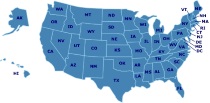Colonial America
Things to See & Do in New Jersey
Lower Delaware National Wild & Scenic River
The lower Delaware River region contains immense resource diversity, combining an area of high population density with a wealth of natural, cultural, and historical resources and recreational opportunities. The river valley houses cliffs rising 400 feet above the rivers that provide for magnificent scenery and habitat unique to the region. The south-facing, desert-like slopes are home to the prickly pear cactus, while the north-facing slopes display flora and fauna usually only found in arctic-apline climates. The river itself provides habitat for American shad, striped bass, and river herring and is an important component of the Atlantic Flyway, one of four major waterfowl routes in North America. From a historic veiwpoint, the river is one of the most significant corridors in the nation, containing buildings used during Washington's famous crossing, historic navigation channels, Native American and colonial archeological sites, and 19th century mills.
Morristown National Historical Park
During two critical winters of the Revolutionary War, 1777 and 1779–80, the countryside in and around Morristown, New Jersey, sheltered the main encampments of the American Continental Army and served as the headquarters of its commander-in-chief, General George Washington. The National Park Service at Morristown National Historical Park preserves sites in the Morristown area occupied by the Continental Army and interprets the history and subsequent commemoration of these encampments and the extraordinary fortitude of the officers and enlisted men under Washington’s leadership. General Washington twice chose Morristown due to its strategic location, including proximity to New York City, defensible terrain, important communication routes, access to critical resources, and a supportive community. The park encompasses ground occupied by the army during the vast 1779-80 encampment, and the site of the fortification from the 1777 encampment. The Ford Mansion, where Washington made his headquarters, is an important feature of the park and recalls civilian contributions to the winning of independence. The national park consists of four non-contiguous units: Washington’s Headquarters with the Ford Mansion and Headquarters Museum, the Fort Nonsense Unit, the Jockey Hollow Unit, and the New Jersey Brigade Area. The Jockey Hollow Unit includes the Wick house (headquarters of General Arthur St. Clair), five reconstructed soldier huts, and approximately 27 miles of walking trails.
Featured Resources
As an Amazon Associate, we earn from qualifying purchases. We get commissions for purchases made through links on this site.
The Story of the World
This book series by Susan Wise Bauer is another that is best enjoyed as a read aloud rather than seen as a history textbook. It is full of engaging stories, mixing facts and historical legends. The companion study guides offer questions, narration exercises, activities, crafts, and reproducible pages. There are also lists for each chapter of supplemental books that are easily found at your local library.
Story of the World: History for the Classical Child, Volume 1: Ancient Times (From the Ear...
100+ New Jersey Drivers Licensing Exam Facts That You Need To Know: Quick Review for the Written Test
Prepare for the New Jersey's Driver's Written Exam. Know the 100+ important facts for the test. Be prepared to ace the exam!
Learning Language Arts Through Literature
Learning Language Arts Through Literature is a fully integrated language arts program that teaches grammar, reading, spelling, vocabulary, writing mechanics, creative writing, thinking skills and more.
Pass Your New York DMV Test Guaranteed! 50 Real Test Questions! New York DMV Practice Test Questions
This book is written by a former DMV classroom instructor. He shares the 50 most common questions and answers to the New York DMV written test. A great guide to help your teen pass the DMV test on their first try.
Handbook of Nature Study
A matchless handbook for decades, this classic work has been the natural history bible for countless teachers and others who seek information about their environment. Written originally for those elementary school teachers who knew little of common plants and animals, and even less about the earth beneath their feet and the skies overhead, this book is for the most part as valid and helpful today as it was when first written in 1911―and revised in the spirit of its authors by a group of naturali...



